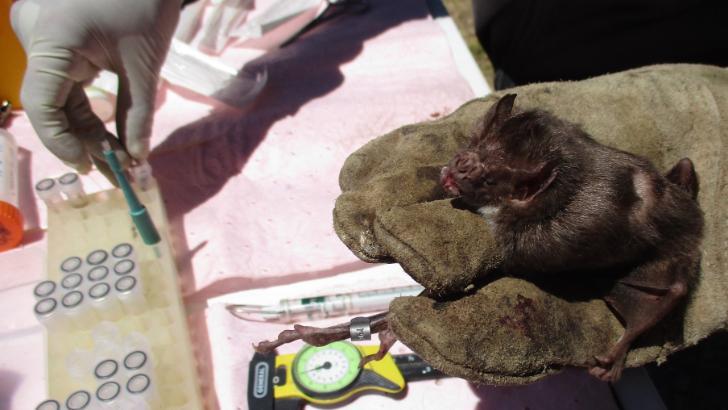Looking for a zoonotic needles in a viral haystack
Published: 6 May 2021
CVR & IBAHCM team develops and validates machine learning models that rank viruses by their ability to infect humans (“zoonotic potential”) using only their genome sequence.
Wild animals are infected by diverse viruses, but only a small minority of these are likely to cause illness in humans. Identifying high-risk wildlife viruses prior to their emergence in humans is therefore a major challenge.

(Common vampire bat (Desmodus rotundus) captured in Peru having samples collected for virus testing as part of a long-term study. Credit: Laura Bergner)
Our team recently developed and validated machine learning models that rank viruses by their ability to infect humans (“zoonotic potential”) using only their genome sequence. In our recent study, we applied these models to newly discovered viruses from common vampire bats. These bats feed nightly on the blood of domestic animals and humans, playing a key role in the transmission of rabies virus throughout the Americas.
Using high throughput sequencing, we discovered viruses from 17 mammal-infecting viral families, including distant relatives of some viruses which cause human diseases including hepatitis E, hepatitis D, rotavirus, enterovirus, and coronavirus. We also detected rabies virus at a surprisingly high frequency in both bat saliva and feces, suggesting these non-invasive samples may be useful for future monitoring of rabies infection in wild bats.
To evaluate the zoonotic potential of the newly discovered viruses, we used machine learning to compare the genome composition of vampire bat viruses to other viruses which have infected humans. These analyses identified three viruses (one virus related to hepatitis E and two viruses related to the human-infecting parechovirus) which were higher priority for further study than all the others. Our study illustrates how applying machine learning models to real-world sequence data can help determine which viruses merit further laboratory or field research.
(Article by Laura Bergner)
You can read the full study here:
Bergner LM, Mollentze N, Orton RJ, Tello C, Broos A, Biek R & Streicker DG. 2021. Characterizing and evaluating the zoonotic potential of novel viruses discovered in vampire bats. Viruses 13(2), 252. https://doi.org/10.3390/v13020252.
Further reading - learn more about the machine learning models here:
Mollentze N, Babayan SA & Streicker DG. Identifying and prioritizing potential human-infecting viruses from their genome sequences. bioRxiv 2020. https://doi.org/10.1101/2020.11.12.379917
First published: 6 May 2021
<< News

